
Thrilled that our paper is out today in Nature!
www.nature.com/articles/s4...
@whatnowning.bsky.social
Neuroscientist / Post-Doctoral Fellow @ IMCB, A*STAR 🇸🇬/ Formerly @MITBrainandCog 🇺🇸& @uclnpp 🇬🇧 / recovering revenge bedtime procrastinator Still building up this account!

Thrilled that our paper is out today in Nature!
www.nature.com/articles/s4...

First neurons didn’t appear overnight. We trace their roots to ancient secretory cells - showing how lifestyle & behavior shaped the evolution of first synapses.🧠🌊 #Evolution #Neuroscience
Our latest in @natrevneuro.nature.com
Link: rdcu.be/eMX3E
@jeffcolgren.bsky.social @msarscentre.bsky.social

Now online @nature.com!
Want to change the consequences of receptor activation?
Small molecules binding the GPCR-transducer interface change G protein subtype preference in predictable ways, enabling rational drug design 💥
So many new possibilities! 🧪🧠🟦
www.nature.com/articles/s41...
🧵👇
The pivot from “I’m building god” to “I’m building a jerkoff tool” is pretty funny
14.10.2025 19:40 — 👍 1355 🔁 267 💬 45 📌 14
Can a single cell learn? Even without a brain, some microbes show simple forms of cognition. Can this basal cognition be engineered? Check our new paper with @jordiplam.bsky.social on the minimal synthetic circuits & their cognitive limits. @drmichaellevin.bsky.social www.biorxiv.org/content/10.1...
10.09.2025 11:48 — 👍 109 🔁 42 💬 4 📌 6
#Throwback 🧪
REVIEW | The time is now: accounting for time-of-day effects to improve reproducibility and translation of metabolism research
S Deota, S Panda et al.

Coming March 17, 2026!
Just got my advance copy of Emergence — a memoir about growing up in group homes and somehow ending up in neuroscience and AI. It’s personal, it’s scientific, and it’s been a wild thing to write. Grateful and excited to share it soon.

I continue to think interneuron circuits are an untapped inspiration in neural network design for context-dependent computation.
05.08.2025 12:05 — 👍 61 🔁 12 💬 4 📌 1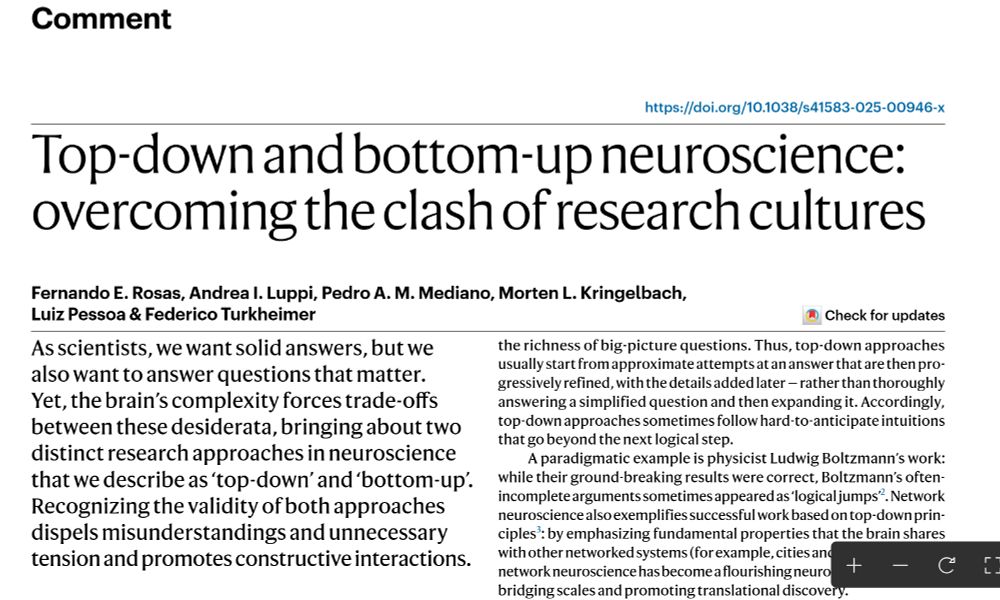
“Top-down and bottom-up neuroscience: overcoming the clash of research cultures”
doi.org/10.1038/s415...
Small contribution in this piece by @frosas.bsky.social and colleagues on how we need both types of research culture in neuroscience.
#neuroskyence
"No animal prior to the advent of modern neuroscience has ever seen repeating sequences of images."
Wonderfully pithy observation @georgkeller.bsky.social love it.

Our work, out at Cell, shows that the brain’s dopamine signals teach each individual a unique learning trajectory. Collaborative experiment-theory effort, led by Sam Liebana in the lab. The first experiment my lab started just shy of 6y ago & v excited to see it out: www.cell.com/cell/fulltex...
11.06.2025 15:17 — 👍 209 🔁 71 💬 7 📌 2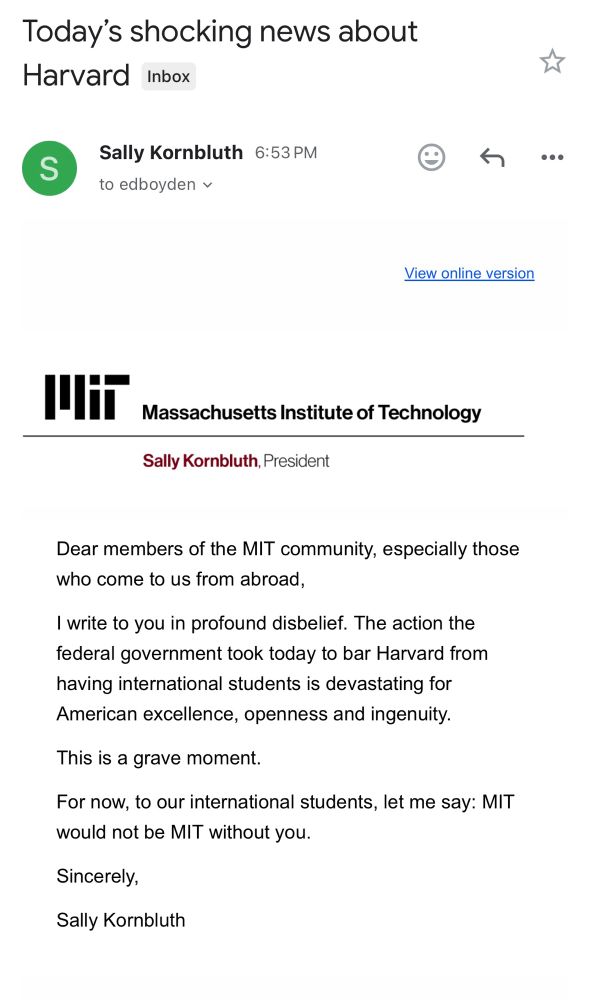 22.05.2025 22:55 — 👍 335 🔁 82 💬 4 📌 7
22.05.2025 22:55 — 👍 335 🔁 82 💬 4 📌 7
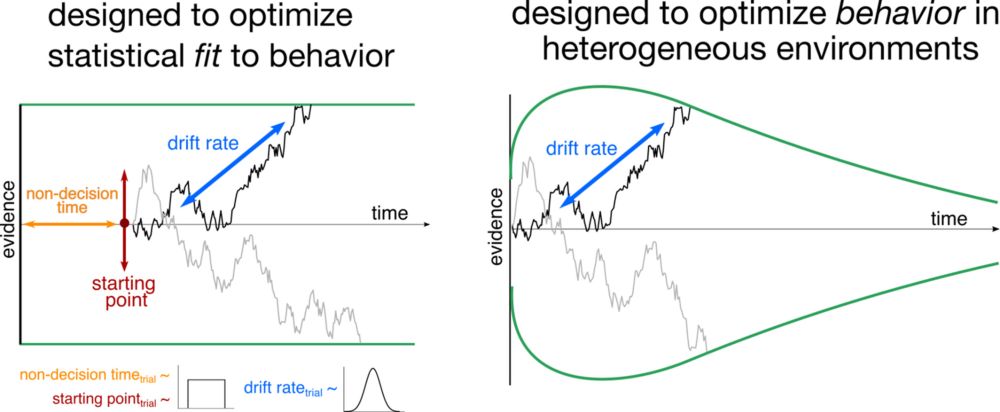
super excited that the first paper from my PhD is now out! we develop a "philosophical toolkit" for computational cognitive modeling & use it to conceptually re-analyze a long-standing debate about evidence accumulation models of decision making 🧠📈 onlinelibrary.wiley.com/doi/full/10....
20.05.2025 23:00 — 👍 94 🔁 34 💬 2 📌 3
Basic pain researchers Steven Prescott and Stéphanie Ratté critique the clinical relevance of preclinical studies in the field and highlight areas for improvement.
By @sydneywyatt.bsky.social
#neuroskyence
www.thetransmitter.org/pain/basic-p...
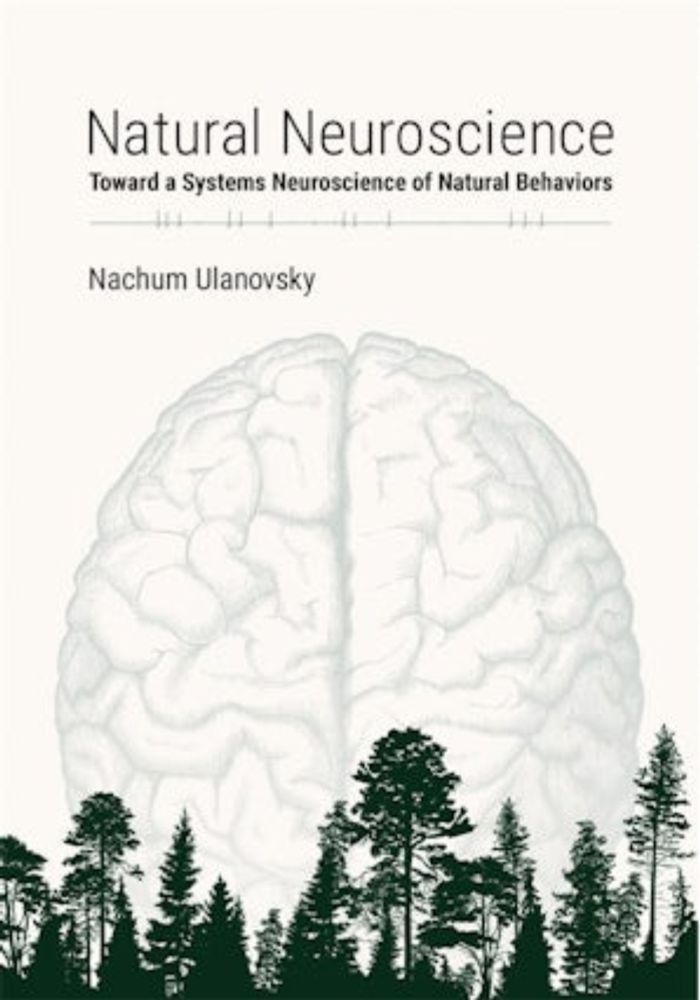
I highly recommend this inspiring new book by Nahum Ulanovsky! A plea for neuroscientists to embrace “Natural Neuroscience”: use emerging technologies to uncover meaningful behavior and neural representations in free-roaming animals exposed to real-world stimuli.
mitpress.mit.edu/978026204499...

🚨new paper alert
Blind mice use stereo olfaction, comparing smells between nostrils, to maintain a stable sense of direction. Blocking this ability disrupts their internal compass.
Kudos to @kasumbisa.bsky.social! Another cool chapter of the Trenholm-Peyrache collab😉
www.nature.com/articles/s41...
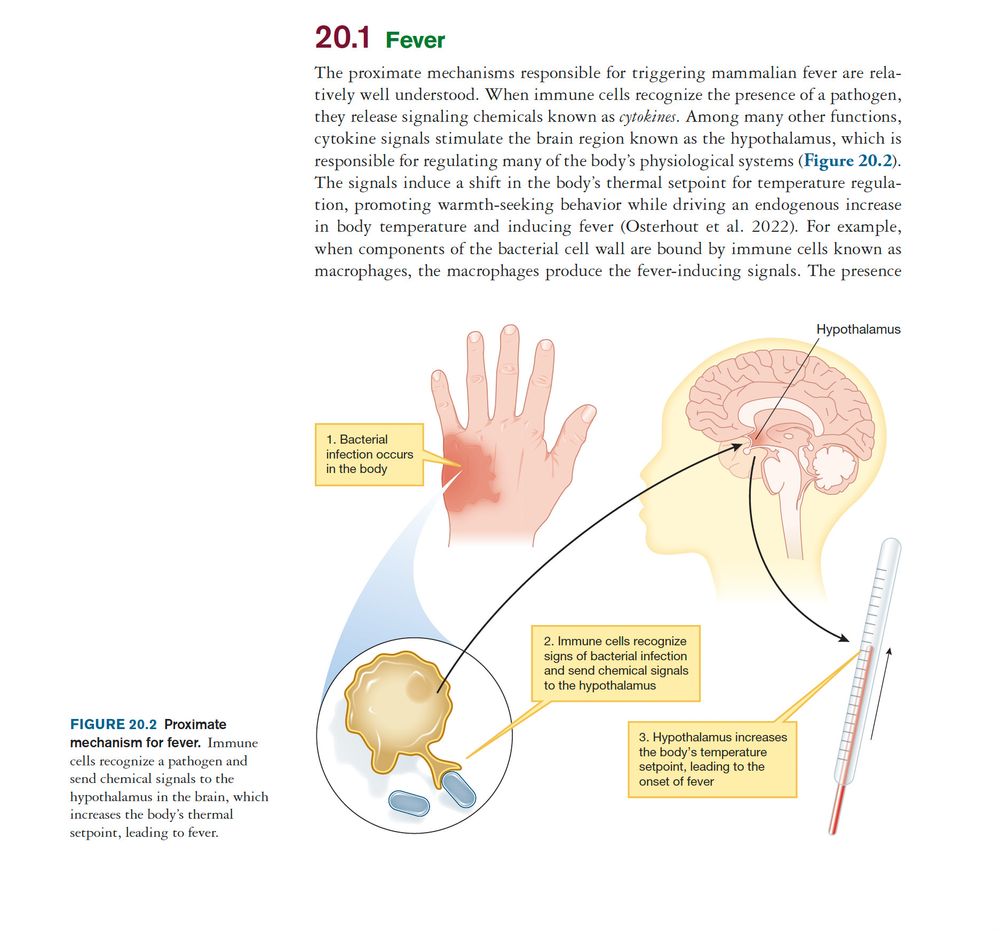
The proximate mechanisms responsible for triggering mammalian fever are relatively well understood. When immune cells recognize the presence of a pathogen, they release signaling chemicals known as cytokines. Among many other functions, cytokine signals stimulate the brain region known as the hypothalamus, which is responsible for regulating many of the body’s physiological systems (Figure 20.2). The signals induce a shift in the body’s thermal setpoint for temperature regulation, promoting warmth-seeking behavior while driving an endogenous increase in body temperature and inducing fever (Osterhout et al. 2022). For example, when components of the bacterial cell wall are bound by immune cells known as macrophages, the macrophages produce the fever-inducing signals. The presence
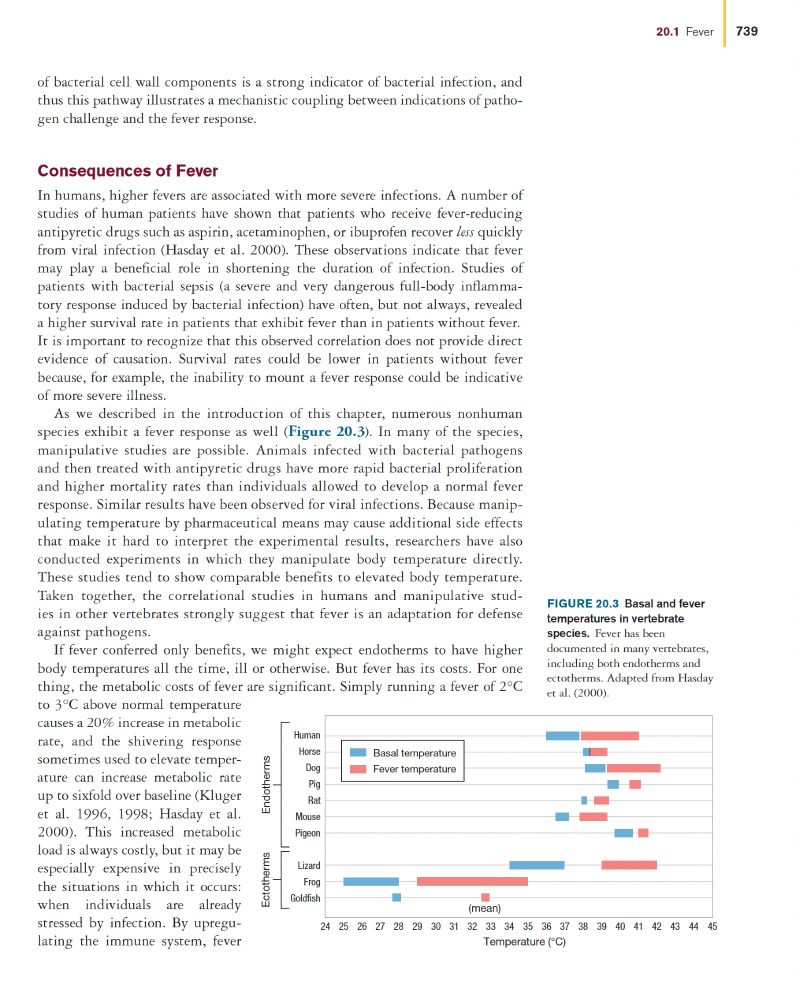
of bacterial cell wall components is a strong indicator of bacterial infection, and thus this pathway illustrates a mechanistic coupling between indications of pathogen challenge and the fever response. Consequences of Fever In humans, higher fevers are associated with more severe infections. A number of studies of human patients have shown that patients who receive fever- reducing antipyretic drugs such as aspirin, acetaminophen, or ibuprofen recover less quickly from viral infection (Hasday et al. 2000). These observations indicate that fever may play a beneficial role in shortening the duration of infection. Studies of patients with bacterial sepsis (a severe and very dangerous full-body inflammatory response induced by bacterial infection) have often, but not always, revealed a higher survival rate in patients that exhibit fever than in patients without fever. It is important to recognize that this observed correlation does not provide direct evidence of causation. Survival rates could be lower in patients without fever because, for example, the inability to mount a fever response could be indicative of more severe illness. As we described in the introduction of this chapter, numerous nonhuman species exhibit a fever response as well (Figure 20.3). In many of the species, manipulative studies are possible. Animals infected with bacterial pathogens and then treated with antipyretic drugs have more rapid bacterial proliferation and higher mortality rates than individuals allowed to develop a normal fever response. Similar results have been observed for viral infections. Because manipulating temperature by pharmaceutical means may cause additional side effects that make it hard to interpret the experimental results, researchers have also conducted experiments in which they manipulate body temperature directly. These studies tend to show comparable benefits to elevated body temperature. Taken together, the correlational studies in humans and manipulative studies in …
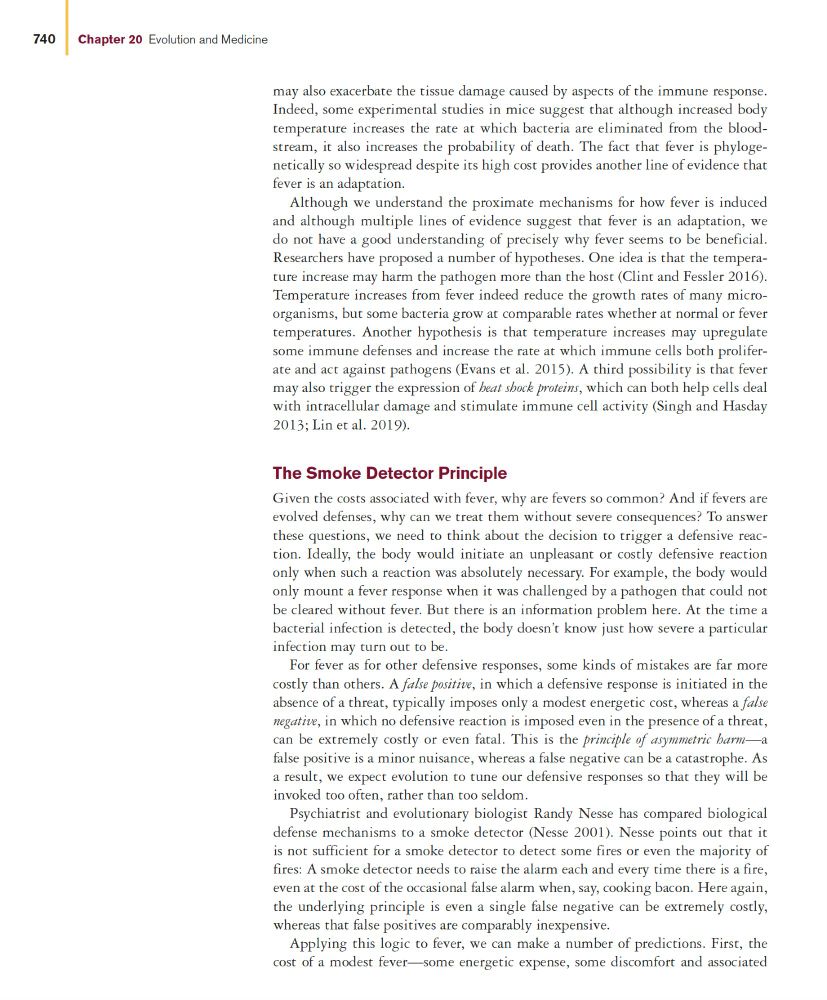
of bacterial cell wall components is a strong indicator of bacterial infection, and thus this pathway illustrates a mechanistic coupling between indications of pathogen challenge and the fever response. Consequences of Fever In humans, higher fevers are associated with more severe infections. A number of studies of human patients have shown that patients who receive fever- reducing antipyretic drugs such as aspirin, acetaminophen, or ibuprofen recover less quickly from viral infection (Hasday et al. 2000). These observations indicate that fever may play a beneficial role in shortening the duration of infection. Studies of patients with bacterial sepsis (a severe and very dangerous full-body inflammatory response induced by bacterial infection) have often, but not always, revealed a higher survival rate in patients that exhibit fever than in patients without fever. It is important to recognize that this observed correlation does not provide direct evidence of causation. Survival rates could be lower in patients without fever because, for example, the inability to mount a fever response could be indicative of more severe illness. As we described in the introduction of this chapter, numerous nonhuman species exhibit a fever response as well (Figure 20.3). In many of the species, manipulative studies are possible. Animals infected with bacterial pathogens and then treated with antipyretic drugs have more rapid bacterial proliferation and higher mortality rates than individuals allowed to develop a normal fever response. Similar results have been observed for viral infections. Because manipulating temperature by pharmaceutical means may cause additional side effects that make it hard to interpret the experimental results, researchers have also conducted experiments in which they manipulate body temperature directly. These studies tend to show comparable benefits to elevated body temperature. Taken together, the correlational studies in humans and manipulative studies in …
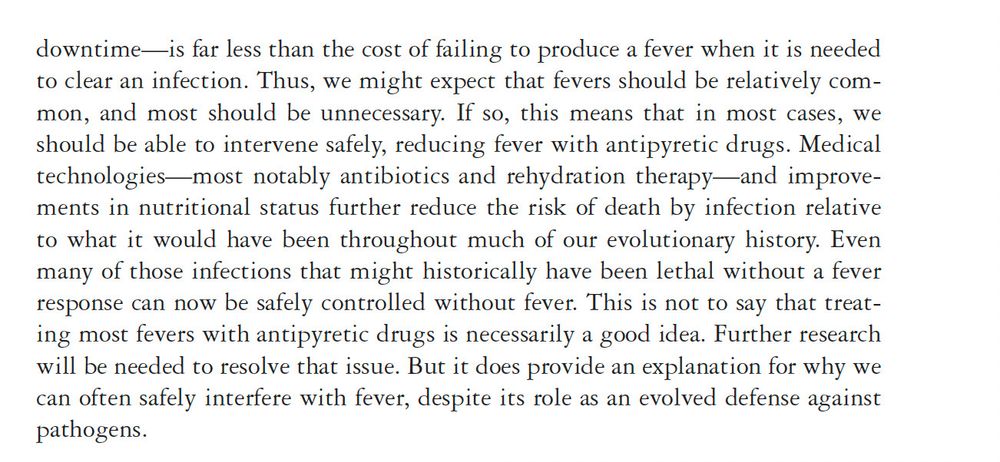
downtime—is far less than the cost of failing to produce a fever when it is needed to clear an infection. Thus, we might expect that fevers should be relatively common, and most should be unnecessary. If so, this means that in most cases, we should be able to intervene safely, reducing fever with antipyretic drugs. Medical technologies—most notably antibiotics and rehydration therapy—and improvements in nutritional status further reduce the risk of death by infection relative to what it would have been throughout much of our evolutionary history. Even many of those infections that might historically have been lethal without a fever response can now be safely controlled without fever. This is not to say that treating most fevers with antipyretic drugs is necessarily a good idea. Further research will be needed to resolve that issue. But it does provide an explanation for why we can often safely interfere with fever, despite its role as an evolved defense against pathogens.
Since people expressed curiosity, here's an excerpt from my textbook Evolution (coauthored with Lee Dugatkin) that addresses fever as an evolved defense and why we can treat it safely nonetheless.
13.04.2025 19:39 — 👍 228 🔁 25 💬 11 📌 5Latest update (same link): spokesperson says the conference ban for scientists is *reversed* & travel can resume "following established approval processes within each Institute & Center."
The reporting shows how much protocol seems to be getting set verbally, and not in writing. Such a disaster.
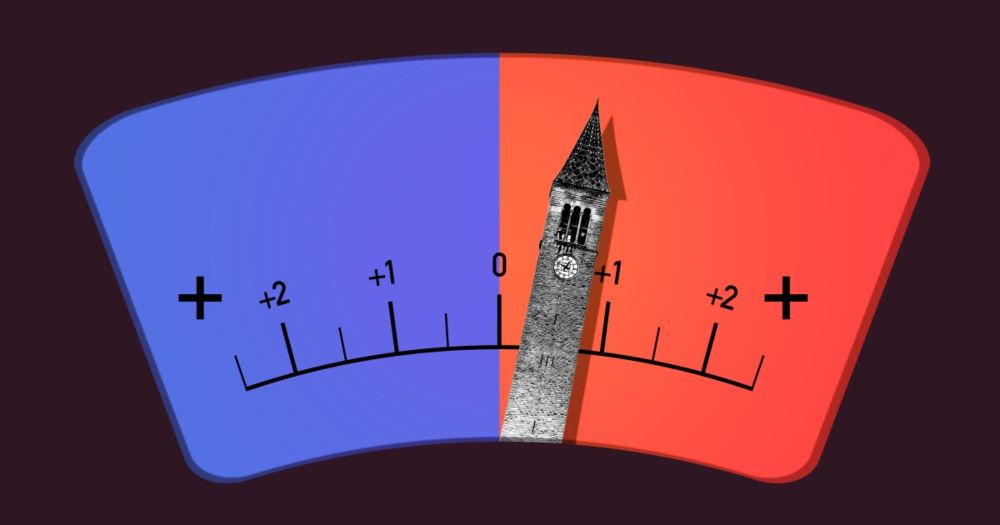
the @chronicle.com has launched what is going to be a tremendously useful tool: a tracker of the Trump administration's activities affecting higher ed, particularly in the areas of civil rights, research, policy, and immigration. check it out: www.chronicle.com/article/trac...
09.04.2025 21:21 — 👍 106 🔁 65 💬 9 📌 3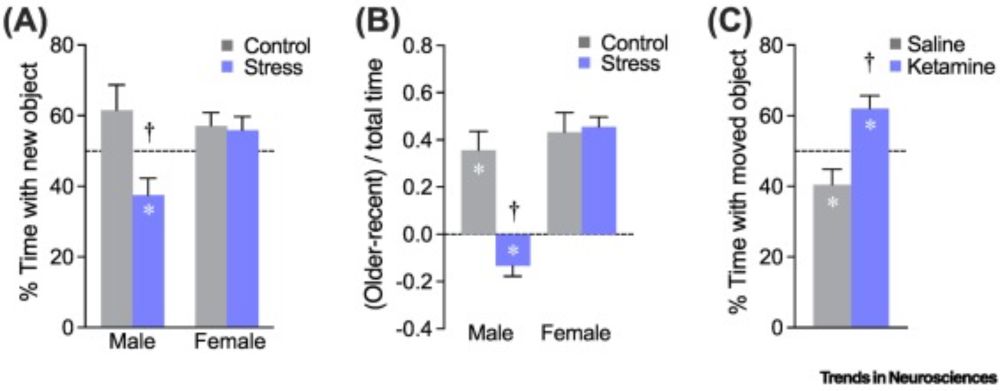
Interesting commentary in @cp-trendsneuro.bsky.social, arguing that we need to be careful not to always assume that rodents prefer novelty:
www.cell.com/trends/neuro...
🧠📈 🧪
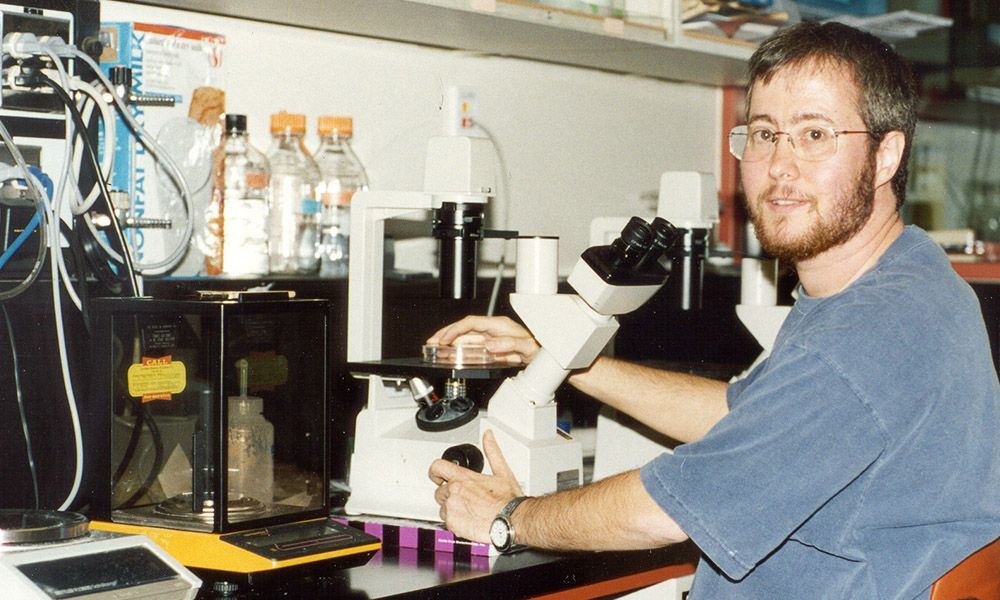
We're disappointed to see Ben Barres's powerful book "The Autobiography of a Transgender Scientist" among the ~400 titles removed from the Naval Academy Library. Needless to say, we're proud to have published his book and will keep it — and his memory — alive.
08.04.2025 20:24 — 👍 2902 🔁 923 💬 19 📌 36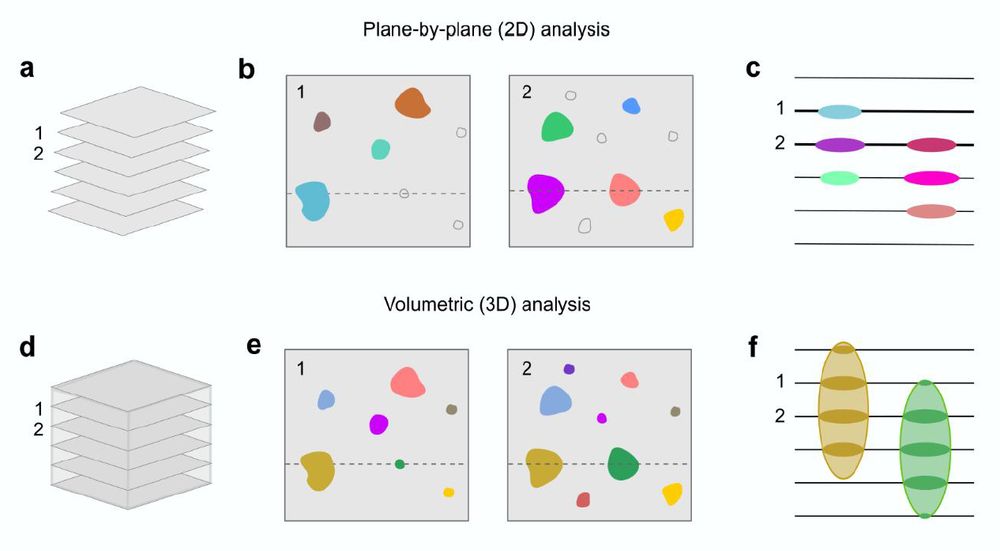
Many of us use 2p scopes to image 3D volumes of brain. But then we analyze the data plane by plane, resulting in duplicated neurons, missed neurons, and low s/n. Let's go 3D!
Suite3D: Volumetric cell detection for two-photon microscopy
by @haydari.bsky.social & team.
www.biorxiv.org/content/10.1...

Kicking off Bluesky with BlueBerry, our open-access, multichannel wireless optogenetic device for freely moving rodents. Visit www.OptoBlueBerry.org for documentation and see its neuroscience applications from large-scale to social settings in our recent preprint: www.biorxiv.org/content/10.1...
30.03.2025 16:52 — 👍 42 🔁 8 💬 0 📌 3Spent a moment compiling drawings from my past few years of funding applications, including so very many drawings of mice.
Posted here in hopes they save someone else the effort:
drive.google.com/file/d/1x_Jo...

As our community increasingly shifts toward embracing the complexity of the brain, this new book by Xiao-Jing Wang will be an essential go-to.
He is among a small, prescient group that embraced important ideas before the rest of us. Here he unpacks them. 1/2
www.taylorfrancis.com/books/mono/1...

This is a bright spot to start the day (on the West Coast, that is). The paper on "possibility space" with @laurennross.bsky.social and Viktor Jirsa is now published!
onlinelibrary.wiley.com/doi/full/10....

Comparison of odorant concentrations in experimental studies, headspace of natural sources, and detection thresholds in rodents.
Glad to share this review of odor concentrations in nature versus experiments, just out in J Neurosci. Spoiler: they are far apart. We discuss implications for olfactory neuroscience and welcome debate. With @neuroboz.bsky.social @dewanlab.bsky.social, Betty Hong. www.jneurosci.org/content/45/1...
10.03.2025 02:59 — 👍 27 🔁 8 💬 0 📌 1 08.03.2025 19:27 — 👍 19339 🔁 6649 💬 355 📌 274
08.03.2025 19:27 — 👍 19339 🔁 6649 💬 355 📌 274